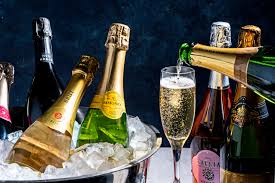SPARKLING WINE
Introduction
Sparkling wine is one of the most
celebrated and festive beverages in the world. Known for its characteristic
bubbles and lively, crisp taste, sparkling wine is synonymous with celebration,
luxury, and tradition. While many people associate sparkling wine solely with
Champagne, it actually encompasses a diverse category produced in numerous
regions and styles. From French Champagne to Italian Prosecco, Spanish Cave to
New World offerings, sparkling wine is a fascinating and multifaceted beverage.
History of Sparkling Wine:
The Champagne region of France
became the benchmark for sparkling wine, especially after advancements in
bottling techniques, sugar addition, and fermentation control. Over time, other
countries developed their own sparkling wine traditions, with Italy’s Prosecco,
Spain’s Cave, and Germany’s Sekt becoming globally recognized styles.
How Sparkling Wine is Made:
The key element that distinguishes
sparkling wine from still wine is the presence of carbon dioxide, which forms
bubbles. The CO₂ is created during fermentation. There are several methods for
making sparkling wine, the most notable of which are:
1. Traditional Method (Methode
Champenoise)
- Used in Champagne and other high-quality sparkling wines, this method involves two fermentation:
- The first fermentation creates a base wine.
- In the second fermentation, sugar and yeast are added to the bottle, which is sealed. The CO₂ from this fermentation is trapped in the bottle, creating bubbles.
- The wine is then aged on its lees (dead yeast cells) for texture and flavor, followed by riddling (turning bottles to consolidate the lees) and disgorgement (removing the lees).
- A dosage of sugar and wine is added before final corking.
2. Charmat Method (Tank Method)
Used widely in Prosecco and
Lambrusco production:
- The second fermentation takes place in a pressurized tank rather than individual bottles.
- It is faster and more cost-effective, producing fresher, fruitier wines with less complexity than those made by the traditional method.
3. Transfer Method: A hybrid of
the traditional and Charmat methods:
- Second fermentation happens in the bottle, but the wine is then transferred to a tank for filtration before rebottling.
Sparkling wine varies in sweetness, color, and intensity. Common classifications based on sweetness include:
- Brut
Nature (0-3 g/L sugar) – Bone dry
- Extra Brut (0-6 g/L)
- Brut (0-12 g/L) – Most common
- Extra Dry (12-17 g/L) – Slightly sweeter than Brut
- Sec (17-32 g/L)
- Demi-Sec (32-50 g/L) – Noticeably pleasant
- Doux (50+ g/L) – Dessert pleasant
- White – Most common
- Rose – Made by blending red and white wines or using red grapes with limited skin contact
Major Types and Regions
1. Champagne (France)
- Grown in the Champagne region under strict regulations.
- Flavors range from citrus, green apple, and brioche to nutty and toasty notes with age.
- Produced via the Char mat method.
- Typically more affordable than Champagne.
- Produced mainly in Catalonia, using traditional methods.
- Common grapes: McCabe, Ballad, and Earl·lo.
- Offers a good balance of freshness and complexity, often with citrus and nutty notes.
- German sparkling wine, with styles ranging from simple and pleasant to complex and dry.
- High-quality Set may be made from Riesling, using the traditional method.
- Countries like Australia, USA, South Africa, and New Zealand produce excellent sparkling wines.
- California, particularly, has top producers like Domaine Carneros and Schramsberg.
The high acidity and bubbles help cleanse the palate, making sparkling wine suitable for rich, fatty, or salty foods.
Storage and Serving Tips
- Serve chilled, around 6–10°C (43–50°F).
- Consume non-vintage bottles within a few years; vintage or prestige covers can age longer.







Comments
Post a Comment